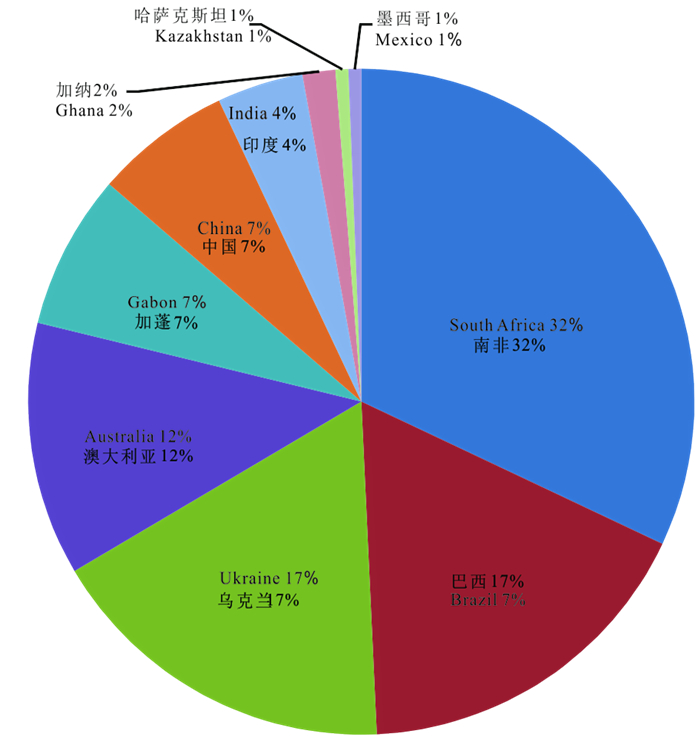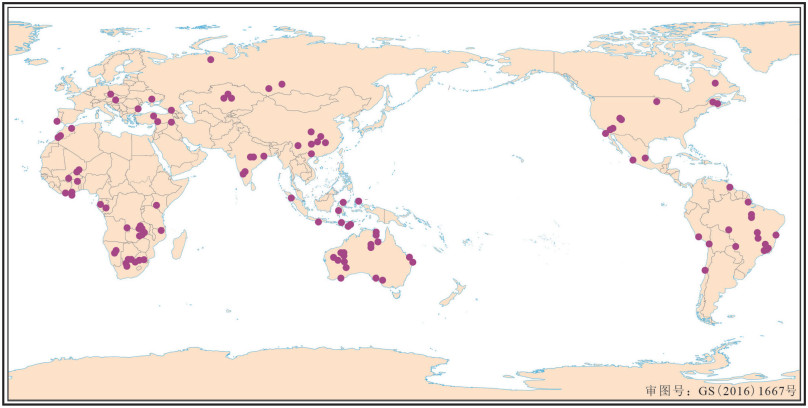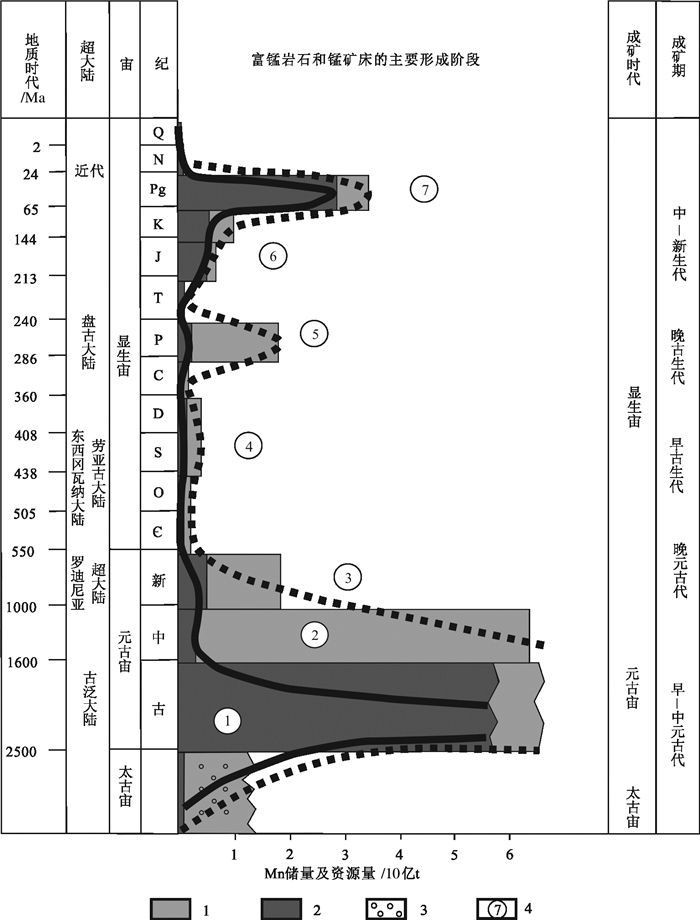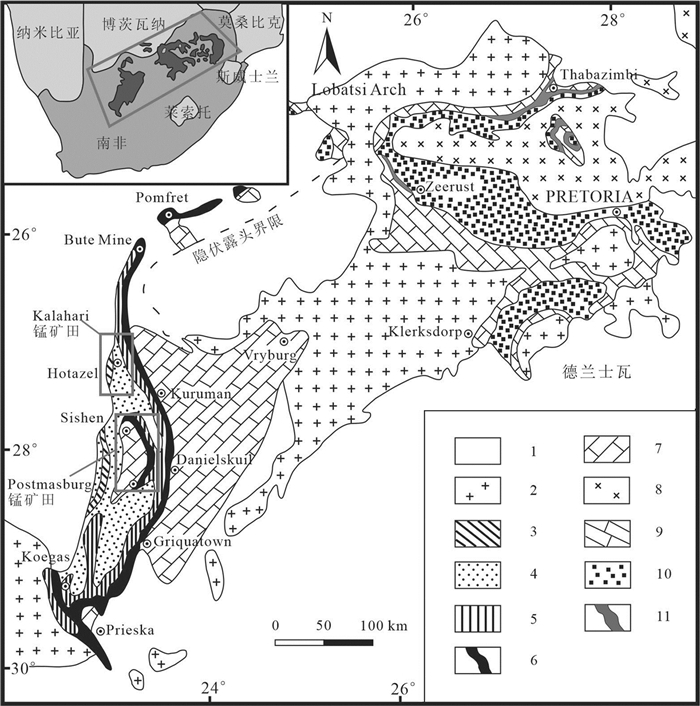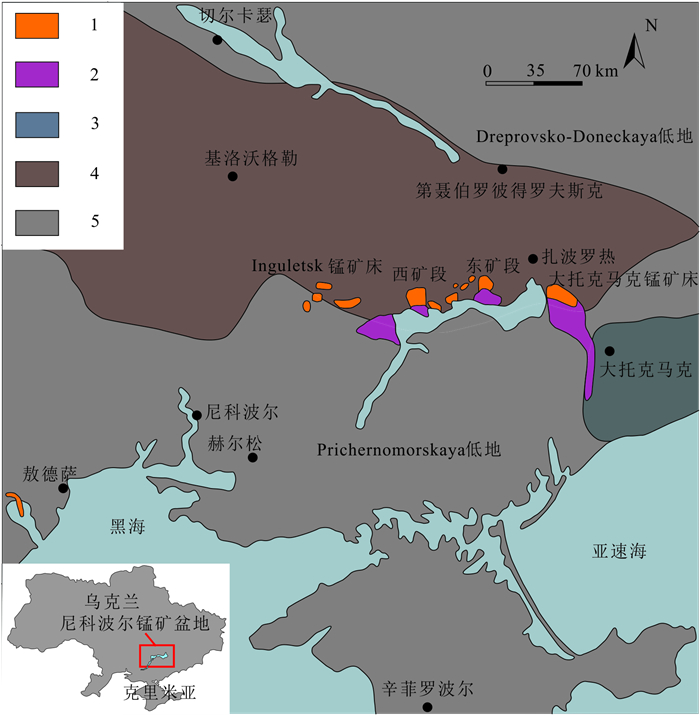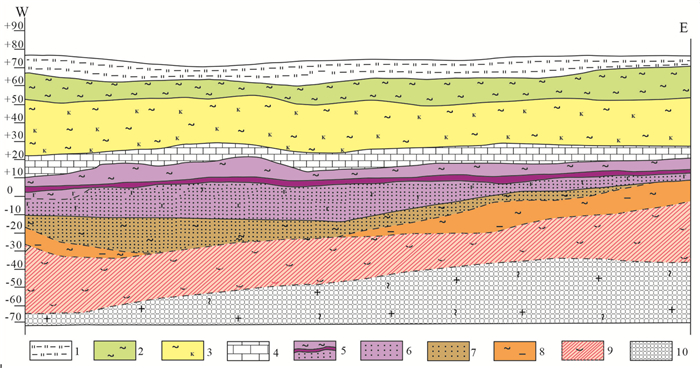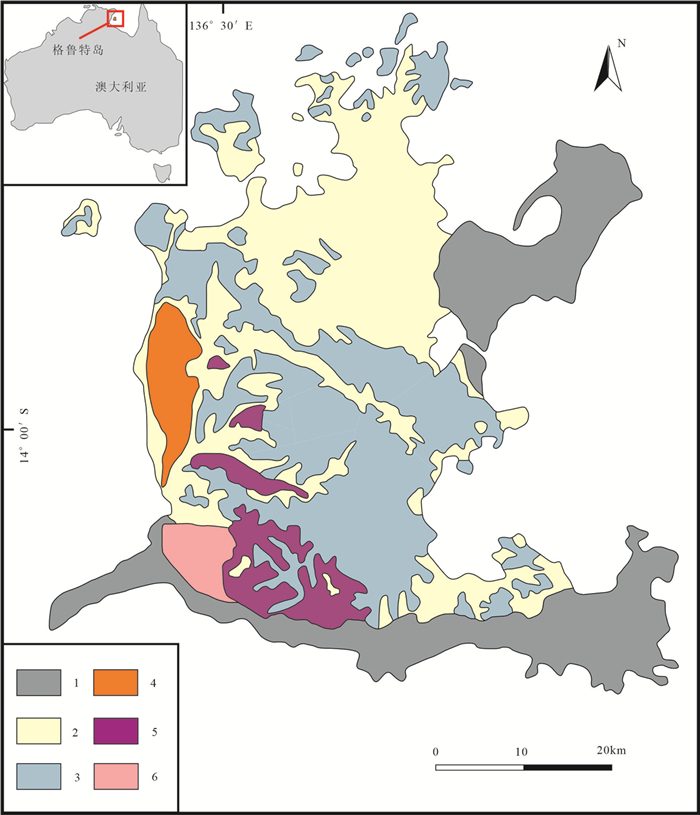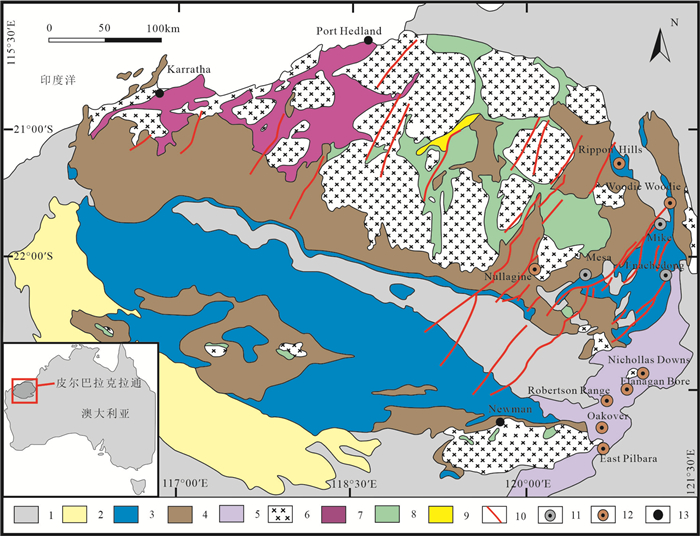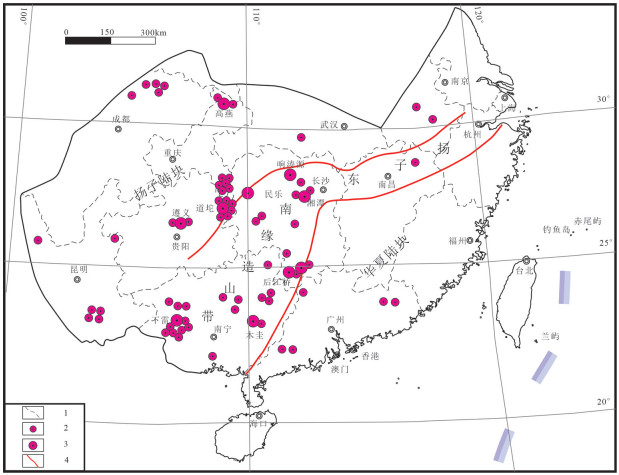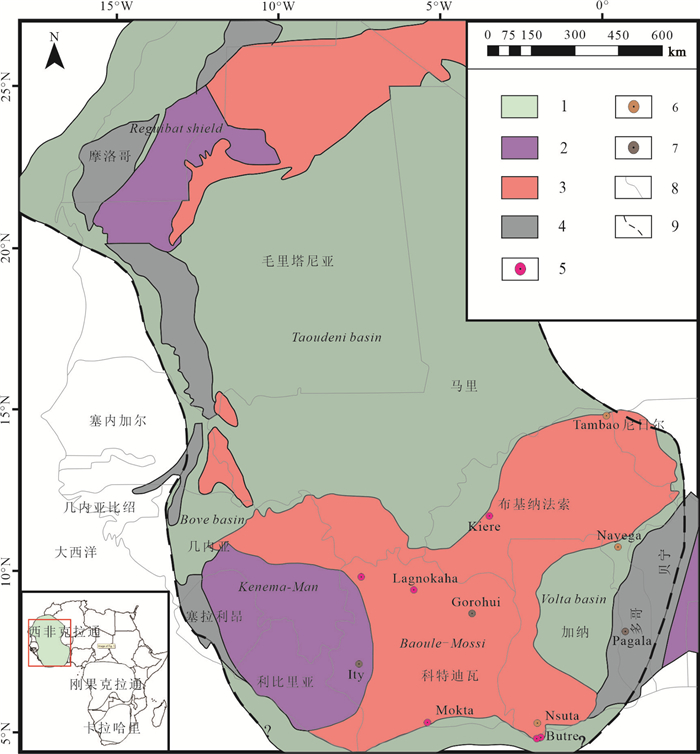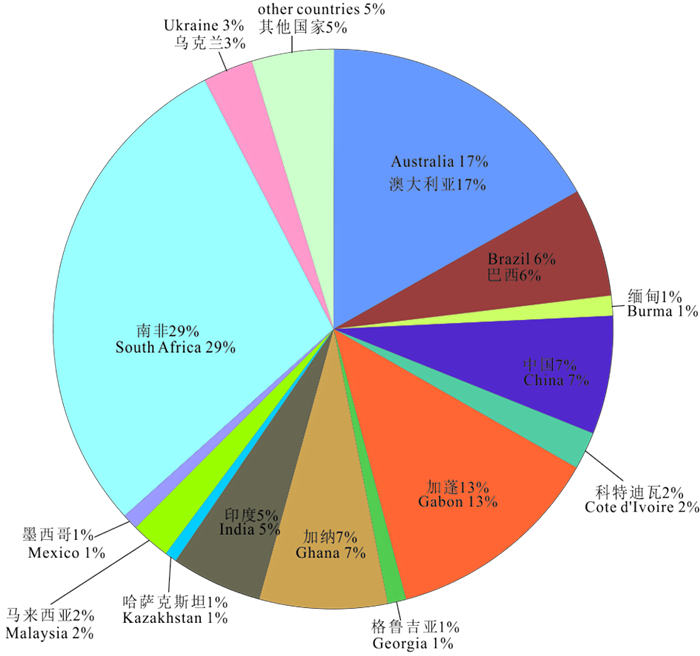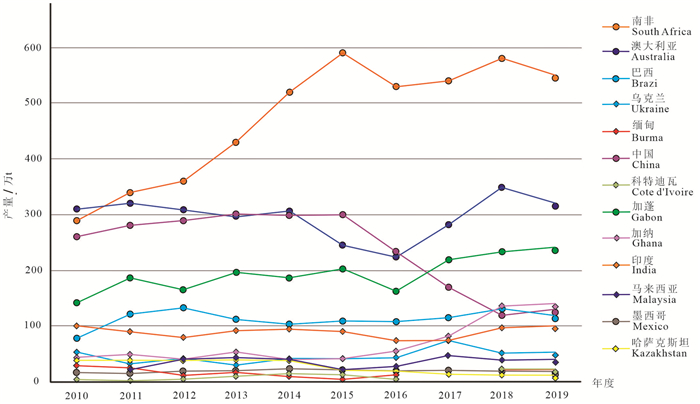-
摘要:
锰的用途非常广泛,世界上90%~95%的锰应用于冶金工业,其余应用于电池工业、陶瓷工业、化学工业等。根据成矿作用过程中的含矿岩系特征,将世界锰矿划分为海相沉积型、火山(热液)-沉积型、变质型、热液型和表生型5类,以海相沉积型、变质型和表生型为主。截至2019年,世界锰的储量达8.12亿t,但分布极不均匀,主要集中在南非、巴西、乌克兰、澳大利亚、加蓬、中国、印度、加纳等国,而优质锰矿石主要分布在南非、澳大利亚、加蓬、加纳。时间上,将锰的成矿作用分为7期,其中元古宙和新生代是主要的成矿期。空间上,锰矿床主要分布在南非德兰士瓦群、乌克兰尼科波尔盆地、澳大利亚格鲁特岛和皮尔巴拉克拉通、中国泛扬子区、西非克拉通等。目前,锰的生产主要集中在南非的卡拉哈里和波斯特马斯堡锰矿田、澳大利亚的格鲁特岛、加蓬的莫安达锰矿、加纳的恩苏塔锰矿等地。
Abstract:Manganese is widely used, 90%~95% of the world's manganese is used in the metallurgical industry, the rest in the battery industry, ceramic industry, chemical industry and so on. According to the characteristics of ore-bearing rocks in the process of mineralization, the world manganese deposits are divided into five types, including marine sedimentary type, volcanic (hydrothermal)-sedimentary type, metamorphic type, hydrothermal type and supergene type, with marine sedimentary type, metamorphic type and supergene type as the main ones. By the end of 2019, the worldwide manganese reserves had reached up to 812 million tons, but their distribution is extremely uneven, mainly concentrated in South Africa, Brazil, Ukraine, Australia, Gabon, China, India, Ghana and so on, while the high quality manganese ores are mainly distributed in South Africa, Australia, Gabon and Ghana. The mineralization epoch of manganese can be divided into 7 periods, of which Proterozoic and Cenozoic are of great importance. Manganese deposits are spatially concentrated in the Transvaal Supergroup of South Africa, the Nikopol ore Basin in Ukraine, the Groote Eylandt and Pilbara Craton of Australia, the Pan-Yangtze area of China, the West African Craton. At present, manganese ore production is mainly concentrated in Kalahari and Postmasburg ore fields in South Africa, Groote Island in Australia, Moanda mine in Gabon and Nsuta mine in Ghana.
-
Keywords:
- manganese /
- type /
- distribution /
- development
-
1. 引言
赣南地区位于南岭成矿带的东段,享有“世界钨都”之称,分布有包括西华山、漂塘、大吉山、画眉坳、盘古山等在内的与燕山期花岗岩有密切成因联系的钨锡多金属矿床(陈毓川等,1989;陈郑辉等,2006;毛景文等,2007;郭春丽等,2007;许建祥等,2008;刘善宝等,2010;方桂聪等,2014;刘丽君等,2017)。与石英脉型钨锡矿床有成因联系的花岗岩大多属于富含Li、F的高分异花岗岩(陈毓川等,1989;张文兰等,2006;王登红,2019;杨斌等,2021;秦拯纬等,2022),且通常伴有铍铌钽等稀有金属矿产,如大吉山矿区69号钽矿体(袁忠信等,1981)、画眉坳钨铍矿床、淘锡坑烂梗子区段的钨铍矿体等(刘善宝,2008)。这些高分异花岗岩与中国西部伟晶岩型锂铍稀有金属成矿花岗岩属于同一成因类型(袁忠信等,1981;李建康,2012;李建康等,2014;王登红等,2017;王成辉等,2019;Wang et al., 2020),但赣南地区石英脉型钨锡矿床是否共伴生有锂金属矿产却鲜有报道。本次工作在南岭东段赣南石雷矿区深部发现了云英岩型锂矿,证实了赣南石英脉型钨锡矿集区也有找锂矿的巨大潜力,这为进一步丰富研究赣南地区钨锡锂矿成矿理论研究和拓展岩体型锂矿找矿勘查空间提供了新思路。
2. 矿区地质特征
赣南位于南岭成矿带的东段,东邻武夷山成矿带,西接南北向的诸广山—万洋山岩浆岩带,由崇义—大余—上犹、于都—赣县、全南—定南—龙南等5个矿集区组成(图 1a)。石雷矿区位于赣南的西南部崇义—大余—上犹钨锡矿集区东段,北北东向的西华山—漂塘—茅坪矿田的中部(图 1b)。整个矿田长度约30 km,十余个矿床呈等间距分布(间距3~5 km),致矿花岗岩具有多阶段演化分异、多阶段侵入和多阶段成矿特征(毛景文等, 1998, 2007;裴荣富和熊群尧,1999;刘善宝等,2010)。
石雷矿区主要出露古生代碎屑岩地层。其中,寒武系类复理石建造分布广泛,且遭受了加里东期强烈褶皱,形成了西部正常东部倒转的复式向斜。泥盆系灰白色巨厚层状砾岩夹紫红色含砾砂岩及石英砂岩层零星分布,与下伏寒武系呈角度不整合接触。矿区中部地表主要出露加里东期石英闪长岩,呈北西展布,形成于434~439 Ma(He et al., 2010)。花岗岩是石雷矿区的主要致矿和赋矿地质体,侵入于石英闪长岩之中,并在接触带形成矽卡岩和似伟晶岩壳。花岗岩为隐伏岩体,钻孔揭露到花岗岩顶面最低标高为-52.93 m (ZK4901),最高标高162.87 m (ZK1107),与漂塘矿区的隐伏花岗岩体(岩凸最高标高为300 m)连为一体。岩相由早到晚依次是黑云母花岗岩((160±0.7)Ma)→二云母花岗岩((159.6±0.7)Ma)→白云母花岗岩((159.9±0.4)Ma),呈逐渐过渡关系,没有明显侵入界限(Zhang et al., 2017)。
矿区共发育7个脉带组,呈北东东走向,倾向北北西,倾角变化在69°~85°,矿脉带长度变化在500~ 1700 m,宽度变化在100~300 m,最大深度超过700 m;除中带脉带组产于加里东期石英闪长岩外,其余脉带均产于寒武系砂岩中,自上而下具有典型的“五层楼”分带特征。本次工作在对矿区11勘探线钻孔进行系统编录过程中,发现深部隐伏花岗岩顶部存在广泛的云英岩带。对钻孔ZKn11-11部分云英岩进行采样测试分析,其中的Li2O变化于0.204% ~0.514%(表 1)。根据其产状和矿物组成,含锂云英岩可以划分为石英脉(±钾长石)+云英岩、云母脉+ 云英岩等两种类型。
表 1 ZKn11-11云英岩W、Sn、Li测试分析结果Table 1. The W, Sn, Li analysis results of greisen samples of ZKn11-11
(1)石英脉(±钾长石)+云英岩复合型锂矿化体:该类型的矿化广泛分布于花岗岩体和围岩(角岩带)中(图 2)。产于角岩带中的石英脉+云英岩复合脉位于隐伏花岗岩体的上部,主要由早期的角岩化、黑云母化和晚期的石英脉复合叠加而成,上部石英呈团块状,下部石英呈脉状穿插于角岩之中(图 2a)。产于花岗岩内接触带二云母花岗岩内石英(±钾长石)+云英岩型锂矿化体以石英脉为中心,其两侧围岩发生云英岩化蚀变,云英岩与二云母花岗岩呈逐渐过渡关系(图 2b)。
![]() 图 2 石雷矿区钨锡锂多金属矿体特征a、e、f—产于角岩化砂岩中的石英脉与黑云母石英复合脉; b、c、g、h—产于二云母花岗岩中的石英脉+云英岩复合脉复合型钨锡锂矿体; i、j—产于二云母花岗岩中的长石石英脉; d、k、l—产于二云母花岗岩中云母脉+云英岩(含钨锡矿化)复合脉; Bt—黑云母; Qtz—石英; Mus—白云母; Kfs—钾长石; Wf—黑钨矿; Py—黄铁矿Figure 2. Characteristics of tungsten, tin and lithium polymetallic ore bodies in the Shilei mining areaa, e, f-Quartz vein and biotite quartz composite vein occurring in hornfelized sandstone; b, c, g, h-Composite W-Sn-Li ore body of Quartz vein and greisen composite vein occurring in mica granite; i, j-Feldspar quartz veins occurring in mica granite; d, k, l-Mica vein+greisen (containing tungsten tin mineralization) composite vein occurred in two mica granite; Bt-Biotite; Qtz-Quartz; Mus-Muscovite; Kfs-K-feldspar; WfWolframite; Py-Pyrite
图 2 石雷矿区钨锡锂多金属矿体特征a、e、f—产于角岩化砂岩中的石英脉与黑云母石英复合脉; b、c、g、h—产于二云母花岗岩中的石英脉+云英岩复合脉复合型钨锡锂矿体; i、j—产于二云母花岗岩中的长石石英脉; d、k、l—产于二云母花岗岩中云母脉+云英岩(含钨锡矿化)复合脉; Bt—黑云母; Qtz—石英; Mus—白云母; Kfs—钾长石; Wf—黑钨矿; Py—黄铁矿Figure 2. Characteristics of tungsten, tin and lithium polymetallic ore bodies in the Shilei mining areaa, e, f-Quartz vein and biotite quartz composite vein occurring in hornfelized sandstone; b, c, g, h-Composite W-Sn-Li ore body of Quartz vein and greisen composite vein occurring in mica granite; i, j-Feldspar quartz veins occurring in mica granite; d, k, l-Mica vein+greisen (containing tungsten tin mineralization) composite vein occurred in two mica granite; Bt-Biotite; Qtz-Quartz; Mus-Muscovite; Kfs-K-feldspar; WfWolframite; Py-Pyrite(2)云母脉+云英岩复合型钨锡锂矿体:产于花岗岩体内接触带的二云母花岗岩中(图 2c),含钨锡石英脉穿插于云英岩中,脉两侧的云英岩中也有浸染状的细粒黑钨矿和锡石产出。
3. 含锂云母成分分析和初步认识
本次研究对11号勘探线两个坑内钻孔ZK11-09、ZK11-10(图 3)中的3件样品进行了分析。将钻孔样品制备为为厚度为30 μm的探针片,然后在国家地质测试实验中心,通过激光剥蚀电感耦合等离子体质谱仪(LA-ICP-MS)分析出云母的成分。分析结果见于表 2。石雷矿区云英岩中的云母中Li2O的含量介于0.18%~0.89%。其中,ZK11-10-B2样品中Li2O的平均含量为0.30%;ZK11-10-B4样品中Li2O的平均含量为0.43%;ZK11-09-B9样品中Li2O的平均含量为0.52%。根据云母的Fetot+Mn+Ti-AlⅥ-Mg-Li图解(图 4),石雷矿区云英岩中的云母应属于白云母—多硅白云母(Guggenhim and Bailey, 1977; Tischendorf et al., 1977; Brigatti et al., 2001)。
表 2 石雷矿区云英岩中云母LA-ICP-MS原位分析结果Table 2. LA-ICP-MS in-situ analysis results of mica of greisen in the Shilei mining area
云英岩是由花岗岩经高温热液作用形成的蚀变岩石,作为钨锡矿重要找矿标志,广泛发育于南岭钨锡矿床之中(陈毓川等,1989)。近年来,关于南岭成矿带及其邻区的钨锡矿床中云英岩带中富锂云母发现的报道陆续出现。不少的研究认为伴生于该类型的锂矿化主要赋存于铁锂云母-锂云母之中,例如栗木矿区的锂云母(李胜虎等,2015),大湖塘、香花岭、茅坪、漂塘、大厂矿区的铁锂云母(Legros et al., 2016, 2018;王正军等,2018;张勇等,2020;Guo et al., 2022)。石雷矿区云英岩中云母类型主要为Li含量较低的白云母—多硅白云母。根据矿山提供的钻孔样品测试分析结果,矿区深部、隐伏岩体顶部的云英岩化具有普遍性,其中仅中矿带角岩化砂岩中的云英岩的Li2O含量可达0.25%(视厚度为2.3 m);二云母花岗岩中发育视厚度为3.08 m,Li2O含量为0.15%~0.27%(平均0.21%)的石英(长石)脉—云英岩复合型锂矿化体;二云母花岗岩中发育的含云母脉云英岩连续4个样品(视厚度为3.08 m)的WO3含量为0.022%~2.61%,Sn为0.013%~ 0.93%;Li2O为0.14%~0.33%(平均0.22%),均达到共伴生品位要求,具有潜在的综合利用价值。该类型伴生的锂矿化的发现证实,钨锡矿中低锂含量云母的大量富集也可形成具有工业价值的锂矿体。此外,富锂云英岩主要发育于晚期的二云母花岗岩之中,其成矿来源显然不可能来自于稍早形成的黑云母花岗岩,但其成矿母岩是否为高分异的锂氟花岗岩,且钨锡矿与锂等稀有金属成矿关系如何依然有待进一步研究(Legros et al., 2018)。总之,该发现丰富了钨锡矿床的成矿理论,拓宽了区域云英岩型锂矿的找矿勘查思路,并为进一步该类型矿床的找矿空间提供了依据。
4. 南岭钨锡矿中云英岩型锂矿成矿潜力及找矿方向
随着锂云母提锂技术的逐渐成熟,赣西北九岭地区岩体型锂矿的找矿突破(李仁泽等,2020),赣南石英脉型钨锡矿床深部及外围云英岩型锂矿的引起了同行的关注(王学求等,2020;娄德波等,2022)。已有的资料表明(陈毓川等,1989),云英岩是岩浆气液交代花岗岩的产物,依据其形态,云英岩可以划分为岩体型和脉带型。岩体型云英岩主要分布于白云母花岗岩体的岩凸部位,如崇义县茅坪钨矿床,云英岩上部产有石英脉型钨锡矿脉带,其下是石英脉+云英岩脉带,呈“草帽”状,是岩体型和脉带型的复合型,主要含锂矿物为铁锂云母和含锂白云母,具有形成大型锂矿床的潜力;脉带型云英岩主要分布在花岗岩与围岩的内接触带上,如九龙脑岩体内洪水寨钨钼锂矿床,西华山钨矿床、张天堂岩体内塘飘孜钨矿床等,其赋矿围岩均为黑云母花岗岩,具有形成中型锂矿床的潜力。
以往的地质勘查工作仅评价云英岩中的钨锡矿,其共伴生云英岩中锂没有进行系统的评价。初步的野外地质调查表明,赣南地区已发现含锂矿物有铁锂云母(茅坪钨矿床、淘锡坝锡矿床等)、含锂多硅白云母(石雷钨锡矿床)、锂云母(铁山垅钨矿床外围),以铁锂云母为主,云英岩中锂含量的高低与含锂云母成正相关,现已发现铁锂云母脉的Li2O含量最高可达1.04%(淘锡坝)。西华山—漂塘—茅坪—塘漂孜钨矿带分布著名的西华山、漂塘、茅坪等大型钨锡矿床,其共伴生的云英岩均有不同程度锂矿化显示,个别矿床具有形成大型锂矿床的潜力。除对已知石英脉型钨锡矿床深部及外围云英岩开展锂矿地质勘查及评价工作外,需要注重对赣南地区花岗岩型锂矿床地质找矿工作部署。目前,龙南九曲地区已经新发现了白云母钠长石锂矿体,这为赣南地区寻找宜春“414”岩体型锂钽矿床提供了很好的线索。
总体上,南岭地区从早古生代特别到中生代强烈的断块运动及相伴随的岩浆活动,对内生稀有元素成矿起着主要作用,稀有元素成矿一般发生在多期活动的晚期岩体之中。随着国家科技水平不断提高, 新一轮科技革命的不断发展, 锂等战略性新兴产业矿产需求量将保持较快增长态势(王登红,2019;陈其慎等,2021;王成辉等,2022),南岭地区云英岩型锂矿的成矿作用研究和找矿勘查也将进一步得到重视。下一步工作中,需要开展同步的成矿理论研究工作,特别是一些复式岩体晚阶段岩浆作用与锂矿化的关系值得高度关注。
5. 结论
南岭东段石雷石英脉钨锡矿深部识别出云英岩型锂矿,含锂矿物主要为白云母-多硅白云母。其中,产于角岩化砂岩中的云英岩Li2O含量平均可达0.25%,二云母花岗岩中石英(长石)脉-云英岩Li2O含量平均为0.21%,二云母花岗岩中发育的含云母脉云英岩Li2O平均为0.22%,具有潜在的综合利用价值。南岭地区具有良好的岩体型锂矿成矿潜力和巨大的找矿前景,石英脉型钨锡矿深部及外围发育的云英岩是主要的找矿目标。
致谢: 审稿专家和编辑老师对论文提出了宝贵的意见和建议,在此表示衷心的感谢! -
图 3 地球不同历史时期锰的储量和资源量分布情况(据Kuleshov, 2011修改)
1—储量;2—资源量;3—太古宙含锰岩石;4—主要成矿阶段
Figure 3. Distribution of manganese reserves and resources in different historical periods of the earth (modified from Kuleshov, 2011)
1-Reserves; 2-Resources; 3-Archen manganiferous rocks; 4-Major Mn metallogenic phases
图 4 南非德兰士瓦群地质简图及主要锰矿床(据Pickard, 2003和Moore et al., 2012修改)
1—盖层;2—基底;3—Griqualand BIF带;4—Griqualand群;5—Griquatown碧玉岩组;6—Kuruman BIF带;7—Campbellrand白云岩;8—Bushveld杂岩体;9—Malmani白云岩;10—Pretoria群;11—Penge BIF带
Figure 4. Simplified geological map of the Transvaal supergroup showing distribution of manganese deposits (modified from Pickard, 2003 and Moore et al., 2012)
1-Cover rocks; 2-Basement rocks; 3-Griqualand BIF; 4-Griqualand Group; 5-Griquatown jasper; 6-Kuruman BIF; 7-Campbellrand dolomite; 8-Bushveld complex; 9-Malmani dolomite; 10-Pretoria Group; 11-Penge BIF
图 5 尼科波尔锰矿盆地地质简图及主要锰矿床(据Kuleshov, 2003修改)
1—氧化锰矿石;2—碳酸锰矿石;3—亚速断块;4—乌克兰地盾;5—黑海沿岸低地
Figure 5. Simplified geological map of the Nikopol ore Basin showing distribution of manganese deposits (modified from Kuleshov, 2003)
1-Oxide ores; 2-Carbonate ores; 3-Azov massif; 4-Ukrainian shield; 5-Prichernomorskaya nizm
图 6 尼科波尔锰矿横截面图(据Ahmet et al., 2020修改)
1—土壤;2—红棕色黏土;3—灰黑色黏土;4—灰岩;5—钙质黏土、石英砂、锰矿;6—石英—海绿石砂;7—黏土;8—炭质黏土和砂;9—风化壳;10—混合岩、斜长花岗岩
Figure 6. Geological cross section of the Nikopol manganese deposit (modified from Ahmet et al., 2020)
1-Loam; 2-Red-brown clay; 3-Dark-gray clay; 4-limestone; 5-Alcareous clay, quartz sand and Mn ores; 6-Quartz-glauconite sand; 7-Clay; 8- Carbonaceous clay and sand; 9-Weathering crust; 10-Migmatite and plagiogranite
图 7 澳大利亚格鲁特岛地质简图(据Pracejus et al., 1988修改)
1—沙丘;2—砂、黏土;3—砂岩;4—豆状MnO2;5—浸染状MnO2;6—含锰钙质粉砂岩
Figure 7. Simplified geological map of the Groote Eylandt (modified from Pracejus et al., 1988)
1-Sand dunes; 2-Sand, clays; 3-Sandstone; 4-Podifrom MnO2;5-Disseminated MnO2;6-Manganiferous calcareous siltstone
图 8 皮尔巴拉克拉通地质简图及主要锰矿床分布(据Blake et al., 2011和Sheppard et al., 2017修改)
1—新生代盖层;2—Ashburton组;3—Hamersley群;4—Fortescue群;5—Maganese群;6—花岗岩;7—西皮尔巴拉地体;8—东皮尔巴拉地体;9—Lalla Rookh盆地;10—断裂;11—BIF型锰矿床;12—表生型锰矿床;13—城市
Figure 8. Simplified geological map of Pilbara Craton showing distribution of manganese deposits (modified from Blake et al., 2011 and Sheppard et al., 2017)
1-Cenozoic sedimentary covers; 2-Ashburton Formation; 3-Hamersley Group; 4-Fortescue Group; 5-Maganese Group; 6-Granite; 7-West Pilbara terrane; 8-East Pilbara terrane; 9-Lalla Rookh basin; 10-Fault; 11-BIF Mn deposit; 12-Supergene Mn deposit; 13-Town
图 9 中国华南地区大中型锰矿分布图(据Xiang et al., 2020和王剑等,2012修改)
1—省界;2—中型锰矿;3—大型锰矿;4—构造边界
Figure 9. Distribution map of large to mid-sized manganese deposits in southern China (modified from Xiang et al., 2020 and Wang et al., 2012)
1-Province boundary; 2-Moderate-size Mn ores; 3-Large Mn ores; 4-Tectonic boundary
图 10 西非克拉通地质简图及锰矿(据Markwitz et al., 2016修改)
1—西非克拉通;2—太古宙;3—古元古代;4—泛非活动带;5—沉积型锰矿;6—沉积型、表生型锰矿;7—BIF型锰矿;8—国界;9—西非克拉通边界
Figure 10. The simplified geological map of the West African Craton showing distribution of manganese deposits (modified from Markwitz et al., 2016)
1-West African Craton; 2-Archean; 3-Paleoproterozoic; 4-Pan-African belts; 5-Sedimentary Mn deposit; 6- Sedimentary and supergene Mn deposit; 7- BIF Mn deposit; 8-National boundary; 9-Boundary of West African Craton
表 1 世界锰矿床成因分类(据谢进,2017修改)
Table 1 The genetic types of manganese deposits in the world (modified from Xie Jin, 2017)

表 2 2019年世界主要锰矿国锰矿储量
Table 2 The world's major manganese ore reserves in 2019

表 3 世界大型锰矿床分布情况
Table 3 The distribution of large-sized manganese deposits in the world

表 4 近10年世界主要锰矿生产国的锰产量(万t)
Table 4 Manganese production of the major countries rich in manganese in the last ten years (ten thousand ton)

表 5 中国2014—2018年度进口的锰资源量(万t)
Table 5 Imported manganese resources of China from 2014 to 2018(ten thousand tons)

-
Ahmet S, Vasyl M Z, Bigle S. 2020. Major, trace and rare earth element (REE) geochemistry of the Oligocene stratiform manganese oxide-hydroxide deposits in the Nikopol, Ukraine[J]. Ore Geology Reviews, 126:1-15 http://www.sciencedirect.com/science/article/pii/S0169136820306284
Beauvais A, Ruffet G, Hénocque O, Colin F. 2008. Chemical and physical erosion rhythms of the West African Cenozoic morphogenesis:The 39Ar-40Ar dating of supergene K-Mn oxides[J]. Journal of Geophysical Research, 113:1-15. doi: 10.1029/2008jf000996
Beukes N J, Burger A M, Gutzmer J. 1995. Fault controlled hydrothermal alteration of Paleoproterozoic manganese ore in Wessels mine, Kalahari manganese field[J]. South Africa Journal Geology, 98(4):430-451. http://sajg.geoscienceworld.org/content/98/4/430
Biondi J C, Lopez M. 2017. Urucum Neoproterozoic-Cambrian manganese deposits (MS, Brazil):Biogenic participation in the ore genesis, geology, geochemistry, and depositional environment[J]. Ore Geology Reviews, 91:335-386. doi: 10.1016/j.oregeorev.2017.09.018
Blake T S, Rothery E, Muhling J R, Drake-Brockman J A P, Sprigg L C, Ho S E, Rasmussen B, Fletcher I R. 2011. Two episodes of regional-scale Precambrian hydrothermal alteration in the eastern Pilbara, western Australia[J]. Precambrian Research, 188(1/4):73-103. http://www.sciencedirect.com/science/article/pii/S0301926811000738
Brusnitsyn A I, Zhukov I G. 2012. Manganese deposits of the Devonian magnitogorsk paleovolcanic belt (southern Urals, Russia)[J]. Ore Geology Reviews, 47:42-58. doi: 10.1016/j.oregeorev.2012.01.003
Chang Honglun, Kong Fanhui, Song Xiaodong, Zhao Jin, Li Jianfeng, Du Jun, Wang Congyin. 2014. Dolostone controls in Postmasburg manganese field of South Africa[J]. Acta Sedimentologica Sinica, 32(5):832-839(in Chinese with English abstract). http://en.cnki.com.cn/Article_en/CJFDTOTAL-DZLP201403011.htm
Chen Yuchuan, Wang Denghong, Xu Zhigang. 2015. Important Mineral and Regional Metallogenic Regularity in China[M]. Beijing:Geological Publishing House(in Chinese).
Chetty D, Gutzmer J. 2012. REE redistribution during hydrothermal alteration of ores of the Kalahari manganese deposit[J]. Ore Geology Reviews, 47:126-135. doi: 10.1016/j.oregeorev.2011.06.001
Cong Yuan, Dong Qingjie, Xiao Keyan, Chen Jianping, Gao Yongbao, Yin Jiangning. 2018. Characteristics and predicted potential of Mn resources in China[J]. Earth Science Frontiers, 25(3):118-137(in Chinese with English abstract). http://www.researchgate.net/publication/327766360_Characteristics_and_predicted_potential_of_Mn_resources_in_China
De Putter T, Liégeois J, Dewaele S, Cailteux J, Boyce A, Mees F. 2018. Paleoproterozoic manganese and base metals deposits at Kisenge-Kamata (Katanga D R. Congo)[J]. Ore Geology Reviews, 96:181-200. doi: 10.1016/j.oregeorev.2018.04.015
Deng Wenbing, Zhang Yanwen, Kong Linghu, Shang Lei. 2019. Current status of manganese ore resources in China and selecting for national physical geological data of manganese ore deposits[J]. China Mining Magazine, 28(9):175-182(in Chinese with English abstract).
Du Q, Yi H, Hui B, Li S, Xia G, Yang W, Wu X. 2013. Recognition, genesis and evolution of manganese ore deposits in southeastern China[J]. Ore Geology Reviews, 55:99-109. doi: 10.1016/j.oregeorev.2013.05.001
Dzigbodi-Adjimah K. 2004. The mineralogy and petrography of the ferruginous manganese rocks at Mankwadzi, Ghana[J]. Journal of African Earth Sciences, 38(3):293-315. doi: 10.1016/j.jafrearsci.2003.08.001
Fairey B J, Timmerman M J, Sudo M, Tsikos H. 2019. The role of hydrothermal activity in the formation of karst-hosted manganese deposits of the Postmasburg mn field, Northern Cape Province, South Africa[J]. Minerals, 9(7):408-436. doi: 10.3390/min9070408
Fu Yong, Xu Zhigang, Pei Haoxiang, Jiang Ran. 2004. Study on metallogenic regularity of manganese ore deposits in China[J]. Acta Geologica Sinica, 88(12):2192-2207(in Chinese with English abstract). http://en.cnki.com.cn/Article_en/CJFDTOTAL-DZXE201412004.htm
Ghosh R, Chakraborty D, Halder M, Baidya T K. 2015. Manganese mineralization in Archean greenstone belt, Joda-Noamundi sector, Noamundi basin, east Indian shield[J]. Ore Geology Reviews, 70:96-109. doi: 10.1016/j.oregeorev.2015.04.007
Gunn A G, Dorbor J K, Mankelow J M, Lusty P A J, Deady E A, Shaw R A, Goodenough K M. 2018. A review of the mineral potential of Liberia[J]. Ore Geology Reviews, 101:413-431. doi: 10.1016/j.oregeorev.2018.07.021
Gutzmer J, Beukes N.J.1995. Fault controlled metasomatic alteration of early Proterozoic sedimentary manganese ores in the Kalahari manganese field, South Africa[J]. Economic Geology, 90:823-844. doi: 10.2113/gsecongeo.90.4.823
Gutzmer J, Du Plooy A P, Beukes N J. 2012. Timing of supergene enrichment of low-grade sedimentary manganese ores in the Kalahari manganese field, South Africa[J]. Ore Geology Reviews, 47:136-153. doi: 10.1016/j.oregeorev.2012.04.003
He Hui. 2017. A present situation of Mn-ore resources and its investigation[J]. China's Manganese Industry, 35(1):23-24(in Chinese with English abstract). http://en.cnki.com.cn/Article_en/CJFDTotal-ZGMM201701007.htm
Hein K A A, Tshibubudze A. 2016. Manganese deposits of the Oudalan province in the northeast of Burkina Faso, and Ansongo Inlier in eastern Mali[J]. Ore Geology Reviews, 78:645-651. doi: 10.1016/j.oregeorev.2015.11.008
Hong Shikun. 2011. Status of China Mn-ore in resources exploitation and the sustainable development[J]. China's Manganese Industry, 29(3):13-16(in Chinese with English abstract). http://search.cnki.net/down/default.aspx?filename=ZGMM201103007&dbcode=CJFD&year=2011&dflag=pdfdown
Hu Dewen, Feng Dandan. 2011. An analysis of the constraints on Chinese manganese industry[J]. China Mining Magazine, 20(6):1-8(in Chinese with English abstract). http://en.cnki.com.cn/Article_en/CJFDTOTAL-ZGKA201106002.htm
Klein C, Ladeira E.A. 2004. Geochemistry and mineralogy of Neoproterozoic Banded Iron Formations and some selected, siliceous manganese formations from the Urucum district, Mato Grosso do Sul, Brazil[J]. Economic Geology, 99(6):1233-1244. doi: 10.2113/gsecongeo.99.6.1233
Kuleshov V N. 2003. Isotopic composition (δ13C, δ18O) and origin of manganese carbonate ores from the early Oligocene deposits, the eastern paratethys[J]. Geochemistry, 63(4):329-363. doi: 10.1078/0009-2819-00029
Kuleshov V N. 2011. Manganese deposits:communication 2. Major epochs and phases of manganese accumulation in the Earth's history[J]. Lithology and Mineral Resources, 46:546-565. doi: 10.1134/S0024490211060095
Laznika P.1992. Manganese deposits in the global lithogenetic system:Quantitative approach[J]. Ore Geology Reviews, 7(4):279-356. doi: 10.1016/0169-1368(92)90013-B
Li Guiliang. 2018. Status quo of manganese ore in China[J]. China's Manganese Industry, 36(3):5-7(in Chinese with English abstract). http://en.cnki.com.cn/Article_en/CJFDTotal-ZGMM201803003.htm
Luo Huabao. 2002. The direction of prospecting for high quality manganese ore resources in China[J]. Geology and Exploration, 38(4):8-11(in Chinese with English abstract).
Maghfouri S, Rastad E, Mousivand F, Choulet F, Ye L. 2017. Geological and geochemical constraints on the Cheshmeh-Frezi volcanogenic stratiform manganese deposit, southwest Sabzevar basin, Iran[J]. Ore Geology Reviews, 89:96-113. doi: 10.1016/j.oregeorev.2017.06.015
Markwitz V, Hein K A A, Jessell M W, Miller J. 2016. Metallogenic portfolio of the West Africa craton[J]. Ore Geology Reviews, 78:558-563. doi: 10.1016/j.oregeorev.2015.10.024
Markwitz V, Hein K A A, Miller J. 2016. Compilation of West African mineral deposits:Spatial distribution and mineral endowment[J]. Precambrian Research, 274:61-81. doi: 10.1016/j.precamres.2015.05.028
Moore J M, Polteau S, Armstrong R A, Corfu F, Tsikos H. 2012. The age and correlation of the Postmasburg Group, southern Africa:Constraints from detrital zircon grains[J]. Journal of African Earth Sciences, 64:9-19. doi: 10.1016/j.jafrearsci.2011.11.001
Nayak B, Das S K, Bhattacharyya K K. 2011. Detrital and authigenic(?) baddeleyite (ZrO2) in ferromanganese nodules of central Indian ocean basin[J]. Geoscience Frontiers, 2:571-576. doi: 10.1016/j.gsf.2011.08.001
Ostwald J. 1988. Mineralogy of the Groote Eylandt manganese oxides:A review[J]. Ore Geology Reviews, 4(1):3-45. http://www.sciencedirect.com/science/article/pii/0169136888900030
Pickard A. 2003. SHRIMP U-Pb zircon ages for the Paleoproterozoic Kuruman Iron Formation, Northern Cape Province, South Africa:Evidence for simultaneous BIF deposition on Kaapvaal and Pilbara Cratons[J]. Precambrian Research, 125(3/4):275-315. http://www.sciencedirect.com/science/article/pii/S030192680300113X
Pracejus B, Bolton B R, Frakes L A. 1988. Nature and development of supergene manganese deposits, Groote Eylandt, northern Territory, Australia[J]. Ore Geology Reviews, 4(1):71-98. http://www.sciencedirect.com/science/article/pii/0169136888900054
Roy S. 2006. Sedimentary manganese metallogenesis in response to the evolution of the earth system[J]. Earth Science Reviews, 77:273-305. doi: 10.1016/j.earscirev.2006.03.004
Salama W, Aref M E, Gaupp R. 2012. Mineralogical and geochemical investigations of the middle Eocene ironstones, El Bahariya Depression, western Desert, Egypt[J]. Gondwana Research, 22:717-736. doi: 10.1016/j.gr.2011.11.011
Sethumadhav M S, Gunnell Y, Ahmed M M, Chinnaiah. 2010. Late Archean manganese mineralization and younger supergene maganese ores in the Anmod-Bisgod region, western Dharwar Craton, southern India:Geological characterization, palaeoenvironmental history, and geomorphological setting[J]. Ore Geology Reviews, 38:70-89. doi: 10.1016/j.oregeorev.2010.06.001
Sharkov A A. 2000. Manganese raw mineral base of russia and problem of its utilization[J]. Razved Okhr Nedr, 11:15-19.
Sheppard S, Krapez B, Zi J W, Rasmussen B, Fletcher I R. 2017. Young ores in old rocks:Proterozoic iron mineralisation in Mesoarchean Banded Iron Formation, northern Pilbara Craton, Australia[J]. Ore Geology Reviews, 89:40-69. doi: 10.1016/j.oregeorev.2017.06.003
U.S.Geological Survey. 2011. Mineral Commodity Summaries[R].
U.S.Geological Survey. 2012. Mineral Commodity Summaries[R].
U.S.Geological Survey. 2013. Mineral Commodity Summaries[R].
U.S.Geological Survey. 2014. Mineral Commodity Summaries[R].
U.S.Geological Survey. 2015. Mineral Commodity Summaries[R].
U.S.Geological Survey. 2016. Mineral Commodity Summaries[R].
U.S.Geological Survey. 2017. Mineral Commodity Summaries[R].
U.S.Geological Survey. 2018. Mineral Commodity Summaries[R].
U.S.Geological Survey. 2019. Mineral Commodity Summaries[R].
U.S.Geological Survey. 2020. Mineral Commodity Summaries[R].
Vafeas N A, Blignaut L C, Viljoen K S. 2019. Arsenic-bearing manganese ore of the Mukulu enrichment in the Kalahari manganese Field, South Africa:A new discrimination scheme for Kalahari manganese ore[J]. Ore Geology Reviews, 115:103146. doi: 10.1016/j.oregeorev.2019.103146
Wang Jian, Duan Taizhong, Xie Yuan, Wang Zhengjiang, Hao Ming, Liu Wei. 2012. The tectonic evolution and its oil and gas prospect of southeast margin of Yangtze Block[J]. Geological Bulletin of China, 31(11):1739-1749(in Chinese with English abstract). http://en.cnki.com.cn/Article_en/CJFDTOTAL-ZQYD201211002.htm
Xiang J, Chen J, Bagas L, Li S, Wei H, Chen B. 2020. Southern China's manganese resource assessment:An overview of resource status, mineral system, and prediction model[J]. Ore Geology Reviews, 116:103261. doi: 10.1016/j.oregeorev.2019.103261
Xie Jin. 2017. Analysis on Investment Prospect of One Belt And One Road Manganese Ore Resources[D]. Beijing: China University of Geosciences (Beijing) (in Chinese).
Xu Shiqi, Xue Chunji, Feng Jing, Feng Changrong. 2019. Study on metallogenic regularity of manganese deposits of Xinjiang[J]. Xiangjiang Geology, 37(2):201-206(in Chinese with English abstract). http://en.cnki.com.cn/Article_en/CJFDTotal-XJDI201902012.htm
Yan Wangsheng, Gao Hailiang. 2009. The resource of Mn ore and its development of Mn-Mining[J]. China's Manganese Industry, 27(3):6-11(in Chinese with English abstract). http://en.cnki.com.cn/Article_en/CJFDTOTAL-ZGMM200903002.htm
Yin Jiangning, Xiao Keyan. 2014. Resources potential analysis and metallogenic prospect of Mn resources in China[J]. Geology in China, 41(5):1424-1436(in Chinese with English abstract). http://www.researchgate.net/publication/288973332_Resources_potential_analysis_and_metallogenic_prospect_of_Mn_resources_in_China
Zang Zhongjiang, Sui Yanhui. 2019. An analysis of the present situation and utilization of manganese ore resources in Russian Federation[J]. China's Manganese Industry, 37(4):1-7(in Chinese with English abstract). http://en.cnki.com.cn/Article_en/CJFDTotal-ZGMM201904001.htm
Zhang Jingsheng, Zhou Guanghua. 2006. A review of manganese ore resources in China and its processing technology progress[J]. China's Manganese Industry, 24(1):1-5(in Chinese with English abstract). http://en.cnki.com.cn/Article_en/CJFDTOTAL-ZGMM200601000.htm
Zhang Jiuling. 1982. Geological characteristics and prospecting direction for domestic and foreign manganese mine[J]. Geology and Prospecting, 18(2):26-40(in Chinese).
Zhou Liuxia. 2000. Mining conditions and problems about China's Mn mines and some proposals[J]. China Mining Magazine, 9(49):51-54(in Chinese with English abstract). http://www.cnki.com.cn/Article/CJFDTotal-ZGMM200001002.htm
常洪伦, 孔繁辉, 宋晓东, 赵晋, 李建锋, 杜俊, 王聪颖. 2014.南非Postmasburg锰矿田白云岩的控矿作用[J].沉积学报, 32(5):832-839. https://www.cnki.com.cn/Article/CJFDTOTAL-CJXB201405005.htm 陈毓川, 王登红, 徐志刚. 2015.中国重要矿产和区域成矿规律[M].北京:地质出版社. 丛源, 董庆吉, 肖克炎, 陈建平, 高永宝, 阴江宁.2018.中国锰矿资源特征及潜力预测[J].地学前缘, 25(3):118-137. https://www.cnki.com.cn/Article/CJFDTOTAL-DXQY201803013.htm 邓文兵, 张彦文, 孔令湖, 尚磊. 2019.中国锰矿资源现状与国家级锰矿床实物地质资料筛选[J].中国矿业, 28(9):175-182. https://www.cnki.com.cn/Article/CJFDTOTAL-ZGKA201909032.htm 付勇, 徐志刚, 裴浩翔, 姜冉. 2014.中国锰矿成矿规律初探[J].地质学报, 88(12):2192-2207. https://www.cnki.com.cn/Article/CJFDTOTAL-DZXE201412004.htm 何辉. 2017.锰矿资源现状与锰矿勘查研究[J].中国锰业, 35(1):23-24. https://www.cnki.com.cn/Article/CJFDTOTAL-ZGMM200402001.htm 洪世琨.2011.我国锰矿资源开采现状与可持续发展的研究[J].中国锰业, 29(3):13-16. doi: 10.3969/j.issn.1002-4336.2011.03.004 胡德文, 冯丹丹. 2011.我国锰矿产业问题分析[J].中国矿业, 20(6):1-8. doi: 10.3969/j.issn.1004-4051.2011.06.001 黎贵亮. 2018.中国锰矿山现状[J].中国锰业, 36(3):5-7. https://www.cnki.com.cn/Article/CJFDTOTAL-ZGMM201803003.htm 骆华宝. 2002.我国优质锰矿的勘查方向[J].地质与勘探, 38(4):8-11. doi: 10.3969/j.issn.0495-5331.2002.04.002 王剑, 段太忠, 谢渊, 汪正江, 郝明, 刘伟. 2012.扬子地块东南缘大地构造演化及其油气地质意义[J].地质通报, 31(11):1739-1749. doi: 10.3969/j.issn.1671-2552.2012.11.001 谢进. 2017.一带一路锰矿资源投资前景分析[D].北京: 中国地质大学(北京). 徐仕琪, 薛春纪, 冯京, 冯昌荣. 2019.新疆锰矿成矿规律研究[J].新疆地质, 37(2):201-206. doi: 10.3969/j.issn.1000-8845.2019.02.010 严旺生, 高海亮.2009.世界锰矿资源及锰矿业发展[J].中国锰业, 27(3):6-11. doi: 10.3969/j.issn.1002-4336.2009.03.002 阴江宁, 肖克炎. 2014.中国锰矿资源潜力分析及成矿预测[J].中国地质, 41(5):1424-1436. doi: 10.3969/j.issn.1000-3657.2014.05.002 臧忠江, 隋延辉. 2019.俄罗斯锰矿资源现状与利用情况[J].中国锰业, 37(4):1-7. https://www.cnki.com.cn/Article/CJFDTOTAL-ZGMM201904001.htm 张泾生, 周光华. 2006.我国锰矿资源及选矿进展评述[J].中国锰业, 24(1):1-5. doi: 10.3969/j.issn.1002-4336.2006.01.001 张九龄. 1982.国内外锰矿主要类型地质特征及找矿方向[J].地质与勘探, 18(2):26-40. https://www.cnki.com.cn/Article/CJFDTOTAL-DZKT198202004.htm 周柳霞. 2000.我国锰矿山的开采现状问题与建议[J].中国矿业, 9(49):51-54. https://www.cnki.com.cn/Article/CJFDTOTAL-ZGKA2000S1009.htm -
期刊类型引用(3)
1. 张学艳,许强平. 安徽省无为市浪尖山黑色熔剂用石灰岩矿地质特征及开采技术条件分析. 地下水. 2025(01): 209-211 .  百度学术
百度学术
2. 沈东升,鲍祺祺,邱钧健,古佛全,龙於洋. 氧化钙对危险废物焚烧飞灰热处理过程中铅释放的抑制. 环境科学学报. 2022(09): 238-244 .  百度学术
百度学术
3. 陆世才,农良春,叶胜,江沙,龙鹏,聂继绩,陈俊宏. 广西平广林场那厘矿区熔剂用石灰岩矿矿床地质特征及成因探讨. 现代矿业. 2022(08): 65-67+72 .  百度学术
百度学术
其他类型引用(1)




 下载:
下载:



